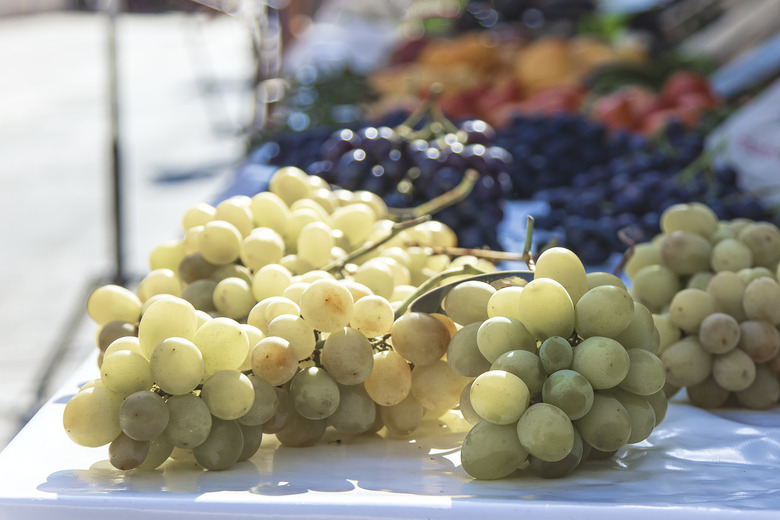Signs Of Bad Quality Grapes
Grapes add a burst of color and a sweet flavor to many dishes, but only if you choose carefully. Whether you're popping them into your mouth as a snack, making your own juice or pepping up your fruit salad, the quality of the grapes you use matters. To get prime flavor, you must harvest grapes at their peak or buy them from a grocer whose supplier has done so. Grapes do not continue to ripen once they're cut from the vine, so what you see is what you get. Carefully examining the size, color and firmness of the grapes will tell you what you need to know. Whenever possible, you should also taste the grapes before bringing them home.
Color
Ripe, high-quality grapes are either blue, red or light green, depending on the variety. Dark green grapes are not yet ripe, so leave them on the vine a bit longer. If you're buying rather than harvesting, pass on any dark green bunches. The variety you recognize as "green" grapes are actually categorized as white grapes. These grapes are ripe when they turn a light chartreuse, a subtle yellow-green.
If a grape is brown or turning brown, it is either going bad or did not get the required nutrients while it was growing. Avoid brown grapes as you would the dark green ones. Look for a uniform color across the grapes on the bunch. If colors vary, the grapes are getting an uneven amount of nutrients.
Some of the grapes on an unevenly colored bunch will taste fine but others will not. Some grapes get their final coloration well before they are ripe, so don't look for color alone when choosing grapes.
Bloom
In the vineyard, grapes develop a powdery white coating called bloom. Harmless to eat and perfectly natural, this bloom protects the grapes from prematurely losing their moisture and beginning to decay. As customers and store employees handle the grapes, this bloom gets wiped away and eventually disappears.
When shopping for grapes in the grocery store, look for this bloom and choose the grapes that have the most. Grapes lacking this powdery coating are likely older and not as fresh as the grapes that still have their bloom.
Size
There is no standard grape size. Grape sizes vary from one cultivar to another but shouldn't vary across the same bunch. Fortunately, you don't need to memorize grape sizes by variety in order to choose tasty grapes. Instead, look for consistency.
The individual grapes in a single bunch should share a fairly uniform size. As is true of color variations, size variations within a single bunch indicate a weak or struggling plant that was unable to support all of its fruit with equal nutrition. Whether standing in your own vineyard or examining supermarket shelves, choose grape bunches with consistently sized grapes as these will likely have the best flavor.
Firmness
Immature grapes are quite firm and lack sweetness. When choosing grapes for purchase or harvest, give them a gentle squeeze. Ripe grapes aren't mushy but they do give a bit when you squeeze them. They should also spring right back when you release them.
Overly soft or mushy spots are a sign of overripe grapes you should avoid. If the grapes are still on the vine and getting soft, then they were not picked soon enough or did not receive the proper amount of nutrients. Either way, it's too late to save them.
Taste
Once you've determined that grapes look and feel good, the only thing left is to do is taste them. Even if grapes give all the indications that they are good, the proof is in the flavor. This is the only way to know for sure that the fruit got all of the nutrients necessary for peak flavor.
In your home garden, tasting grapes is easy. Simply pluck one from the vine and pop it into your mouth. If it's not yet sweet, leave the bunch on the vine a bit longer. If you want to taste your grapes but you're in the grocery store, resist the urge to discreetly pop one in your mouth. Instead, seek out a manager or employee and get permission to do a taste test. Some will allow you to do so for free while others may charge a small fee.
